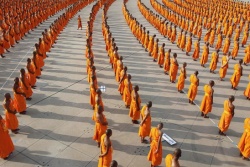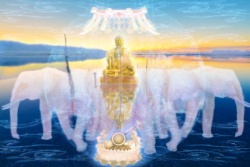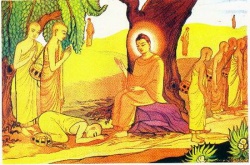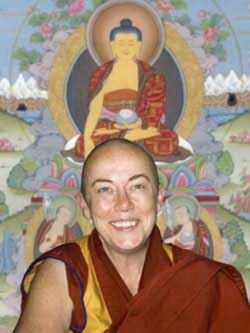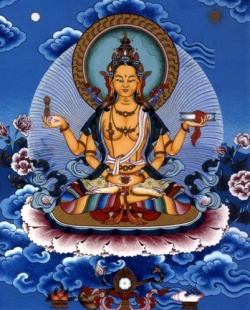Arahat-ship
The state of an Arhat. Also arahatship.
Is Theravada Buddhism for Arahatship Only?
Ven. U Silananda
Although Theravada Buddhism is known more widely than before nowadays, there are still some misunderstandings concerning it.
There are still people who believe and say (or rather write) that Theravada is for Arahantship only.
Before we talk about this subject, we must understand the meaning of the word arahant.
According to Theravada Buddhist teachings, an arahant is a person who has reached the fourth and highest stage of enlightenment.
All those who have reached this stage are called arahants, worthy ones.
Worthy of what? Worthy of accepting gifts from devotees, because gifts made to those persons bring abundant results.
According to this definition, all those who have reached this stage, both disciples and Buddhas (and Pacceka-Buddhas also), are called arahants.
There are numerous places in the Pali Canon where the Buddha is referred to as arahant, see for instance the formula of homage which Buddhists say everyday: "Namo Tassa Bhagavato Arahato Sammasambuddhassa!"; observe also the statement in the Mahavagga of Vinaya Pitaka,
"There are now six arahants in the world", i.e., the five first disciples and the Buddha.
But arahant is also used to refer to the disciples only, and it is in this sense that the word arahant is used hereafter in this article.
According to Theravada teachings, there are three kinds of beings who have reached the fourth stage of enlightenment: Buddhas, Pacceka-Buddhas, and Arahants.
Arahants are also called Savakas or Disciples; they are subdivided into Aggasavaka (the Best Disciples), Mahasavaka (the Great Disciples) and Pakatisavaka (the Ordinary Disciples).
All of these beings are enlightened persons, but their quality of enlightenment differs from one another.
The enlightenment of the Buddhas is the best, that of Pacceka-Buddhas is inferior to the enlightenment of the Buddhas, but is superior to the enlightenment of the Arahants, and the enlightenment of the Arahants is the lowest of them all.
Buddhas can ‘save’ many beings, or rather they can help many beings ‘save’ themselves by giving them instructions, but Pacceka-Buddhas do not ‘save’ beings because they are solitary Buddhas and do not teach as a rule.
The Arahants can and do ‘save’'beings, but not as many beings as Buddhas do.
And the time required for the maturity of the qualities of these beings differ greatly.
To become a Buddha, one has to fulfill the Paramis (necessary qualities for becoming a Buddha) for four, eight or sixteen Incalculables and 100,000 worlds cycles; but for a Pacceka-Buddha the time is only two Incalculables and 100,000 world cycles.
Among the Disciples, for an Aggasavaka, the time required is one Incalculable and 100,000 world cycles, while for a Mahasavaka, it is only 100,000.
But for the Pakatisavaka, it may be just one life, or a hundred lives, or a thousand lives, or more.
It is important to note that once a person becomes an arahant, he will not become a Buddha in that life; and since there is no more rebirth for him, he will not become a Buddha in the future either.
In Theravada Buddhism one is not forced to follow the path to Buddhahood only, but is given a choice from among the paths mentioned above. So a Theravada Buddhist can aspire for and eventually reach Buddhahood; indeed he must be determined to fulfill the Paramis for the long, long time required for the fulfillment of Buddhahood.
Or if he so desires, he may aspire for Pacceka-Buddhahood, or one of the states of Arahantship and suffer in the round of rebirths for the time required for his particular choice of the path accumulating the necessary Paramis and ‘save’ as many beings as they can.
So a Theravada Buddhist is free to choose what suits his willingness to go through the round of rebirths and suffering.
In brief, a Theravada Buddhist can become a Buddha, or a Pacceka-Buddha, or an Arahant according to his choice.
So Theravada Buddhism is for all three paths and not for the path to Arahantship only.
Here comes another question: If a Theravada Buddhist can choose any path, why is the attainment of Arahantship so much talked about in Theravada Buddhism?
It is because only very few can become Buddhas.
As you know (if you have read so far, of course), an aspirant for Buddhahood has to undergo a lot of suffering for a long, long time in the round of rebirths making sacrifices no other being even dreams of; and there can be only one Buddha at a time in the whole world, so that the appearance of a Buddha is very, very rare.
Therefore, for every being to aspire for Buddhahood is impractical; it would be like all native citizens of the United States trying to become a President of the United States.
Moreover, the purpose of becoming a Buddha is to ‘save’ beings or ‘help beings save themselves.’
But if everybody were to become a Buddha, there would be no beings for a Buddha to ‘save’–please note that Buddhas do not need any instructions from anybody–and so the original purpose would not be served.
On the contrary, to become an Arahant is very practical, and millions of beings attained Arahantship during the time of a Buddha.
That is why, in Theravada Buddhism, beings are encouraged to try to become Arahants which is practical rather than to become Buddhas which is not so.
But as stated before, beings are given freedom to follow the path of their choice in their endeavor for attainment of enlightenment.
After all, what is important for all beings is to get free from suffering in the round of rebirths no matter which path they choose.
Still another question: Are there Theravada Buddhists who aspire for Buddhahood? We are glad to answer in the affirmative. But since not many of them are on record, we cannot say how many.
At least there was a king in Myanmar during the Pagan Period who built a pagoda and dedicated it to the Dispensation of the Buddha.
In that pagoda he left an inscription where he clearly declared his aspiration for Buddhahood; and almost all kings of ancient Myanmar considered themselves to be aspirants for Buddhahood.
There are also authors of religious books, mostly monks, who mentioned their aspiration for Buddhahood at the end of their books.
So, we can say that there are not a few Theravada Buddhists who aspire for Buddhahood .
